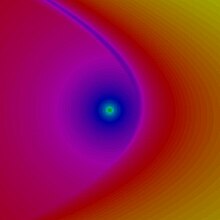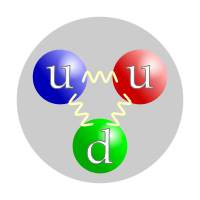Point particle
[2] A point particle is an appropriate representation of any object whenever its size, shape, and structure are irrelevant in a given context.When a point particle has an additive property, such as mass or charge, it is often represented mathematically by a Dirac delta function.[6] The fundamental equation of electrostatics is Coulomb's law, which describes the electric force between two point charges.However, neither elementary nor composite particles are spatially localized, because of the Heisenberg uncertainty principle.For example, see atomic orbital: The electron is an elementary particle, but its quantum states form three-dimensional patterns.


Newton's law of universal gravitationsimple pendulumideal gasCoulomb's forceidealizationparticlesphysicsextensionDirac delta functionquantum mechanicsHeisenberg uncertainty principleelementary particleatomic orbitelectronhydrogen atomelectronsquarkscomposite particlesprotonsclassical physicsmatterinfinitesimallinear dimensionsgravity3-dimensional spaceNewtonian gravitationcenters of massinverse square lawelectromagnetismelectric chargeequationelectrostaticsCoulomb's lawEarnshaw's theoremequilibriumelectric fieldup quarksdown quarkgluonscomposite particlephotonprotonneutronwavepacketatomic orbitalquantum superpositionquantum statesclassical electron radiusTest particleCharge (physics)Standard ModelWave–particle dualityNortonCambridge University PressUniversity of California PressBenjamin MotteEncyclopedia AmericanaGrolier OnlineAddison-WesleyProceedings of the Physical SocietyBibcodeAmerican Journal of Physics